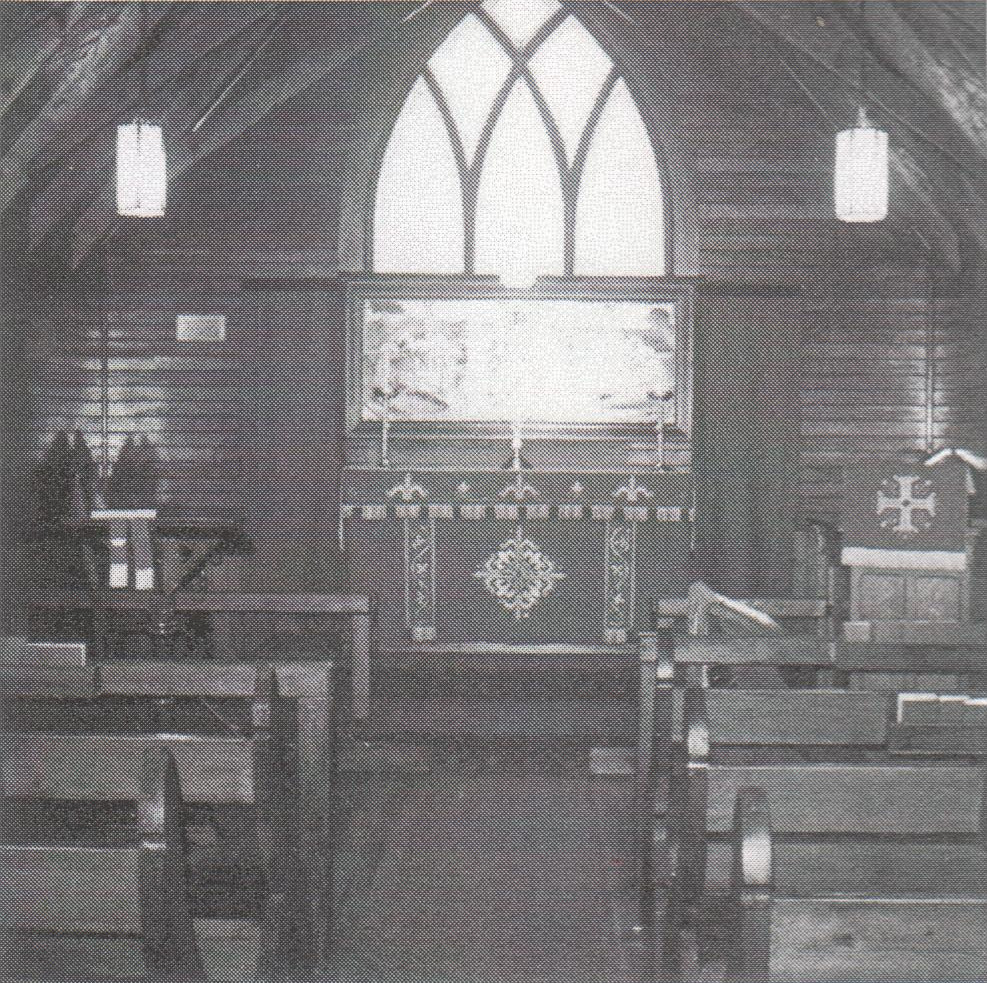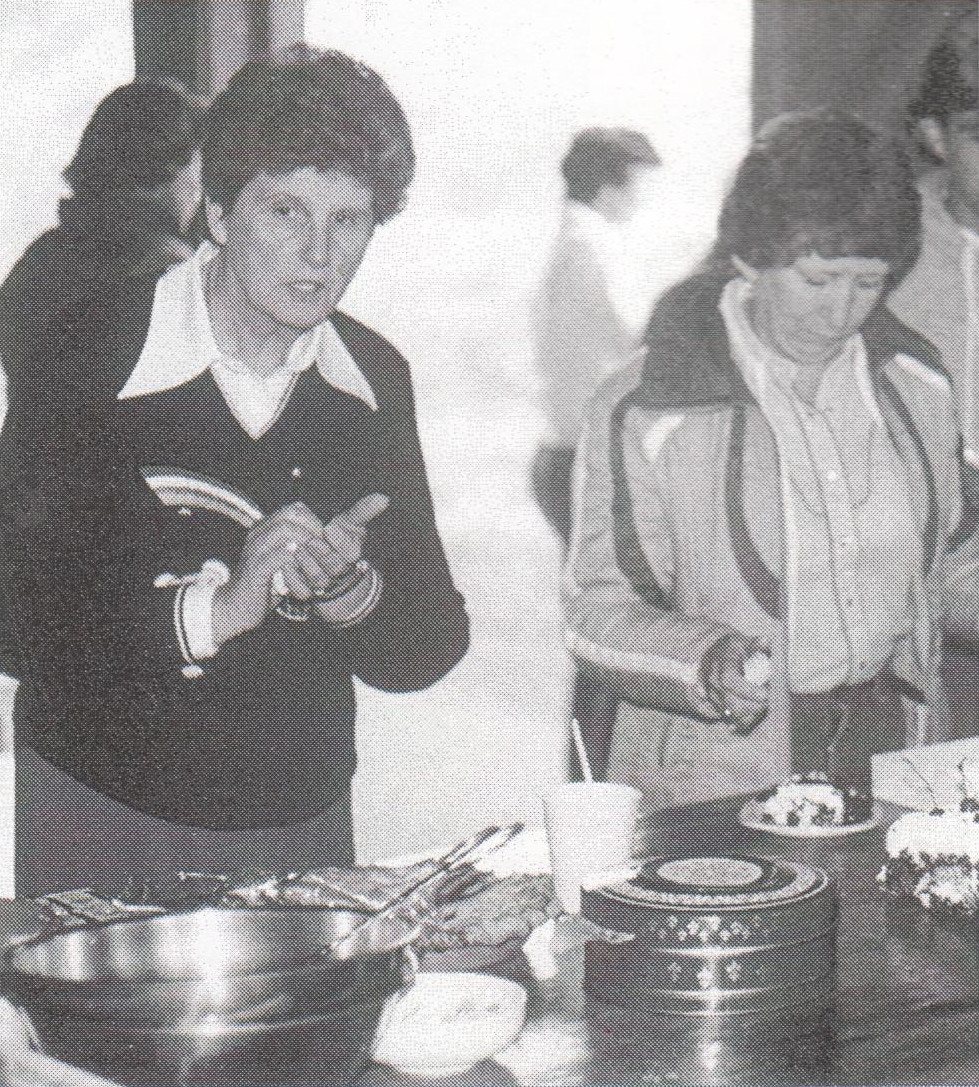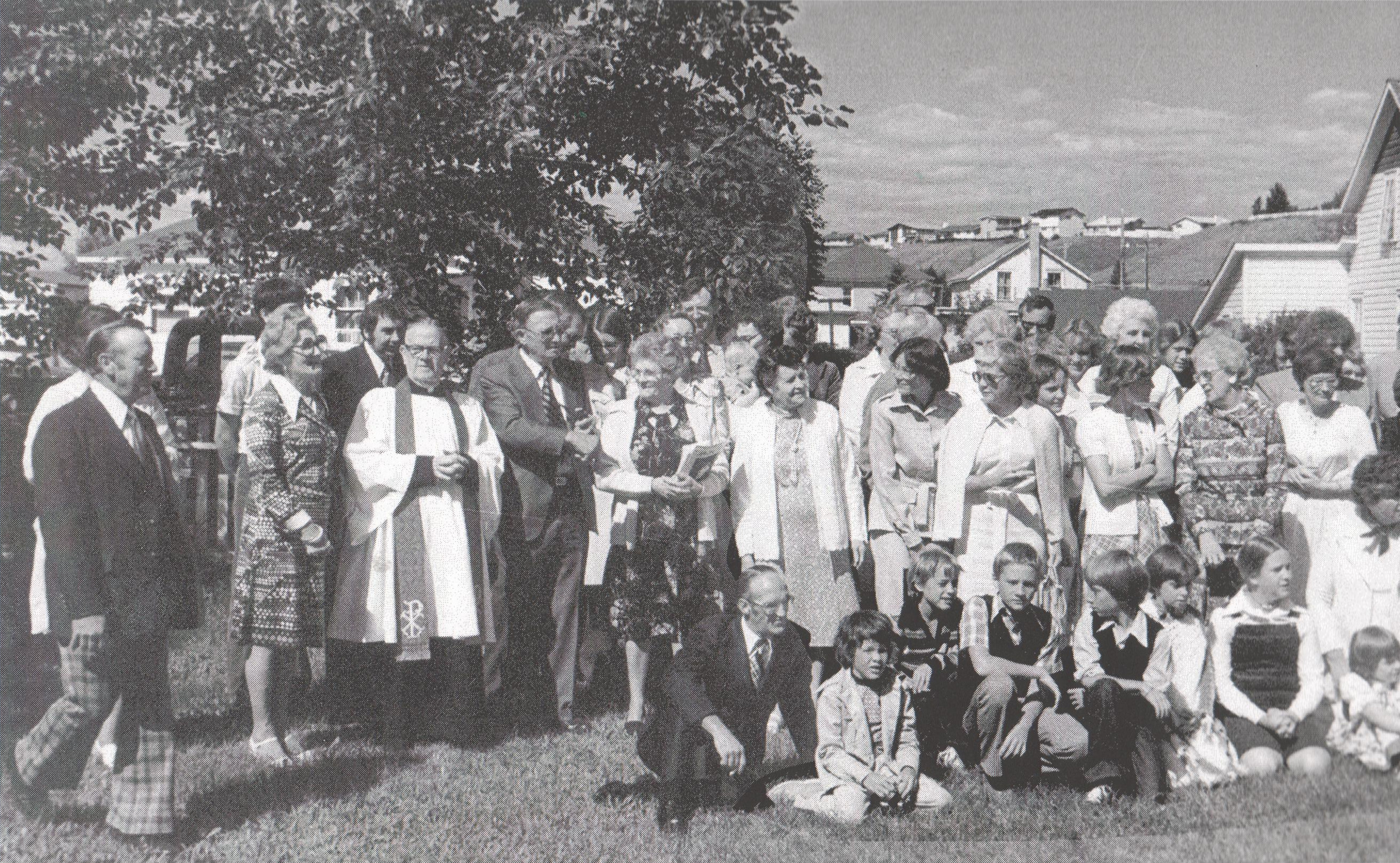All Saints Altar Guild
by Robin Harvie
As the congregation of All Saints increased in the early 60s, the church became more active. The Rev. Tom Wright conducted regular services, mostly Evensong, traveling from Canmore where he was the incumbent.
A group of ladies became interested in forming an altar guild. In previous years, the Ladies Guild had prepared the altar for services.
In February, 1964, the Altar Guild began with six members: Margaret Leith, Robin Harvie, Sharon Engert, Helen Elliott, Molly Broatch (as liaison with Ladies Guild), and Shirley Thomas. Margaret Leith headed the group as Directress. They were responsible to the priest in charge, and their duties included preparing the altar for services, whether Matins or Eucharist, cleaning silver and brass, washing and ironing linens, and changing hangings to the appropriate color for the seasons. The presiding priest inducted new members at a special service.
First on our agenda was to have an altar built. Before that, a wooden framework from a packing case had sufficed. The silk brocade frontals, full length, had, been attached by thumbtacks, one color on top of the other, and rotated as needed.
Herman Leith built and donated an altar of walnut. We purchased Altar Guild manuals for each member to learn about the vestments and the various linens, hangings, and communion vessels, and how to care for them.
Monthly meetings were held. We paid dues of $1.50 / year, and extra change was collected at each meeting.
The sacred nature of our duties was stressed, and we followed a strict discipline. Before we entered the sanctuary, we were to pray quietly:
Almighty God, grant we beseech Thee, that we may handle Holy things with reverence, and perform our work with such faithfulness and devotion that it may rise with acceptance hefore Thee and obtain Thy blessing through Christ our Lord. Amen
When Altar Guild began. there was a partial set of white brocade hangings with embroidered roses in the centre of all but the curtains. There was one white piece with a beautiful mauve design. These were made in England when the church was built, and were very worn. A very old partial red set with embroidery was still in use. To round out the required colours of the Church year we had a green set and a purple velvet set, which had been made by one of the ladies of the Guild. We had one fair linen cloth (for the altar), two purificators (12 inch squares), one pall (a firm linen-covered square to set on the chalice), and two veils, one green and one purple, (to cover the communion vessels prior to eucharist).
Firstly, we made new white linens, hemming them by hand and embroidering each with crosses in white. These were laundered with great care, and the water was afterward poured on the ground, never down the drain.
Water used to wash the chalice was also poured onto the ground, as this was considered more reverent. This custom was no longer required by the priest after 1967.

We gradually replaced the colored hangings with new ones. St. Stephen's in Calgary gave us a green set they no longer used.
In 1966, Rev. Wright retired, and Rev. Douglas Blackwell and his wife, Sandra, moved into our newly purchased rectory Sandra had served on the Altar Guild at St. Stephen's in Calgary, and had learned from the ladies there how to do the ecclesiastical embroidery.
Sandra joined our Altar Guild, and with her help we made and embroidered a red silk brocade set of hangings.
Hank Engert, Sharon's husband, made frames for each of us to use in working the embroidery. In subsequent years when we made purple, green and white hangings, we appliqued emblems on to the pieces, and finished the edges of the appliques by hand in gold thread. Rather than full length frontals, we made superfrontals, a short version with fringe. Then our beautiful altar was visible below.
Each of the sets of hangings was dedicated at a service, so again the sacredness of our work was stressed.
In addition to the care of linens and brocade hangings, we cleaned and polished brass candlesticks and vases and the silver chalice, wafer box, and wine cruet. All had been in the church a very long time except the wafer box, which was donated by Mrs. Leith in 1965.
In those early years, there was little money for such things as sewing materials, linen, brocade, flowers, candles, communion wafers, or cleaning supplies. We sold Regal Christmas cards for a few years, and then produced a cookbook in 1965 to help cover expenses.
In 1967, Mrs. Leith resigned as Directress when she moved to Calgary. Robin Harvie assumed the position. The title, Directress, always raised some eyebrows, but that was the term used in our Altar Guild Manual, so we stayed with it. At that time, the dues were raised to $2.00/year.

The membership changed as people came and went. Jean Blackwell and her family joined the church in 1965, and she became a member of altar guild in 1968. Various new members over the years were Kathleen Welham, Diane McClennon, Margaret Kerfoot, Muriel Peverell, Doris Ashton, Brenda Sine, Christine Goodman, Sharon McGraw, Joy Ceelen, Mayda Hicklin, Judie Goody, Dot Pellow, Frances Hill, Janet Russell, Alison Dobruk, Margaret Hunziker, Joyce Archer, Gladys Lemmon, Joyce Clapperton, and Pauline Murray.
In 1968, the kneelers were cushioned and covered with red naugahyde (artificial leather) at a cost of $70.00. The Anglican Church Women paid for this. We made two white brocade cushions for use at weddings, and six communion veils were hemmed for confirmations.
It was customary to have a corporate communion during each year, if not at a regular service then at a meeting in one of our homes.
The guild established a Flower Box in the church that people could donate to at any time. Thus there was a small fund so flowers could be purchased for special occasions. At the February, 1968 meeting, a bank balance of $18.82 was reported.
The second set of hangings was purple brocade, made in 1969, and they replaced the purple velvet ones. A set consisted of a superfrontal the length of the altar, short, fringed, with appliques as decoration; a veil to cover the chalice; a burse which is a two—sided firm pocket which sits on top of the chalice and holds extra linens; a small banner fringed and decorated to hang from the prayer desk, and another to hang from the lectern.
Full length curtains were made to hang on either side of the altar. A funeral pall was made from the old set of purple velvet hangings which could cover a casket in the event of a funeral in our church.
In January 1975, Robin resigned as Directress, and Jean Blackwell took over.
In 1977, new white dossal curtains were made. The old, original white frontal was made into a shorter superfrontal and a prayer desk fall. The embroidery was carefully cut out and reapplied to the fall. A veil and burse were also made.
When Bishop Douglas Ford became our incumbent in 1982, he asked the Altar Guild Lladies to make a full set of green hangings, including superfrontal, veil, burse, prayer desk and lectern falls, and dossal curtains. The measurements were taken and the silk brocade ordered from Dominion Regalia in Toronto. The cost was $115.00 per yard. For five yards, lining, thread, appliques, fringe the total was $806.13. The Memorial Fund covered the cost of these supplies.
Jean Blackwell and Robin Harvie undertook the sewing. Making the first cut in the material was very nerve-wracking, as the material was very expensive. We spent hours measuring the sizes of the pieces needed, and positioning them on the material so as not to waste an inch. We spent a whole day getting everything just right, and finally cut each piece out very carefully.
Perhaps a little too much visiting got in the way, as, to our horror, we discovered we had cut the dossal curtains four inches too short.
What to do! When we calmed our panic and started to think, we decided to make wide loops across the top for the rod to slide through. We found embroidered ribbon which we applied to the loops, and put a band of the ribbon across each curtain near the bottom.

The curtains turned out very well, and they were dedicated in November, 1983. They were much admired. Most people thought we had planned to do the curtains that way. A fortunate result to a bad mistake!
A special gift was made to the church by Mrs. Hill, who donated a sterling silver baptismal shell from Canon Hill's collection.
A note in the minutes of March, 1984 concerned the wine being moved to the rectory for storage. It seems to have been vanishing 'very quickly'.
Over the next few years, the members of the Guild continued their service week after week with care and devotion. From time to time, new purificators were sewn, and mending was done when necessary. Palm crosses were made before Easter for many years until crosses made in third world countries were ordered by the Diocese.
Whenever a priest retired and a new priest arrived, there were some changes in the routine. In 1991, when Rev. Derek Dunwoody became the incumbent, the altar was moved away from the wall, and the pulpit was removed. He requested a missal cushion to elevate the service book on the altar, making it more readable.
Jean Blackwell resigned her position in 1989, and Robin Harvie resumed the position for three years until 1992. Christine Goodman became Directress then, and continues to this day.
When All Saints Church was moved to Bethany Care Centre in Cochrane in 2004 to become a chapel for the residents, the Altar Guild left some hangings for their use.
During our interim time worshiping in Holy Spirit School, efforts have been made to continue in the best way possible. Some sewing has been done as linens wore out, but the brocade hangings have been packed carefully away.
When we move into our new Anglican home, which at present is St. Mary's Roman Catholic Church, it will be a challenge to adapt what we have to what we need.
Once again, we will strive to learn the best way to care for the altar, the linens and the communion vessels that are an integral part of our worship.
It has been an honour to serve God in this way for each one of us.

